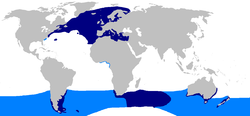Porbeagle shark
| Porbeagle | |
|---|---|
 |
|
| Scientific classification | |
| Kingdom: | Animalia |
| Phylum: | Chordata |
| Class: | Chondrichthyes |
| Subclass: | Elasmobranchii |
| Superorder: | Selachimorpha |
| Order: | Lamniformes |
| Family: | Lamnidae |
| Genus: | Lamna |
| Species: | L. nasus |
| Binomial name | |
|
Lamna nasus (Bonnaterre, 1788) |
|
 |
|
| Confirmed (dark blue) and suspected (light blue) range of the porbeagle | |
| Synonyms | |
|
Lamna philippii Perez Canto, 1886 |
|
Lamna philippii Perez Canto, 1886
Lamna punctata Storer, 1839
Lamna whitleyi Phillipps, 1935
Oxyrhina daekayi Gill, 1861
Selanonius walkeri Fleming, 1828
Squalus cornubicus Gmelin, 1789
Squalus cornubiensis Pennant, 1812
Squalus monensis Shaw, 1804
Squalus nasus Bonnaterre, 1788
Squalus pennanti Walbaum, 1792
Squalus selanonus Leach, 1818
The porbeagle (Lamna nasus) is a species of mackerel shark in the family Lamnidae, distributed widely in the cold and temperate marine waters of the North Atlantic and Southern Hemisphere. In the North Pacific, its ecological equivalent is the closely related salmon shark (L. ditropis). The porbeagle typically reaches 2.5 m (8.2 ft) in length and a weight of 135 kg (298 lb); North Atlantic sharks grow larger than Southern Hemisphere sharks and differ in coloration and aspects of life history. Gray above and white below, the porbeagle has a very stout midsection that tapers towards the long, pointed snout and the narrow base of the tail. It has large pectoral and first dorsal fins, tiny pelvic, second dorsal, and anal fins, and a crescent-shaped caudal fin. The most distinctive features of this species are its three-cusped teeth, the white blotch at the aft base of its first dorsal fin, and the two pairs of lateral keels on its tail.
The porbeagle is an opportunistic hunter that preys mainly on bony fishes and cephalopods throughout the water column, including the bottom. Most commonly found over food-rich banks on the outer continental shelf, it makes occasional forays both close to shore and into the open ocean to a depth of 1,360 m (4,460 ft). It also conducts long-distance seasonal migrations, generally shifting between shallower and deeper water. The porbeagle is fast and highly active, with physiological adaptations that enable it to maintain a higher body temperature than the surrounding water. It can be solitary or gregarious, and has been known to perform seemingly playful behavior. This shark is aplacental viviparous with oophagy, developing embryos being retained within the mother's uterus and subsisting on non-viable eggs. Females typically bear four pups every year.
...
Wikipedia

